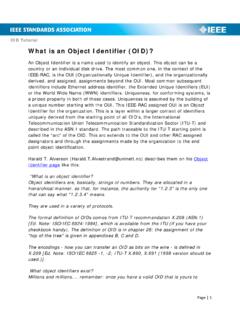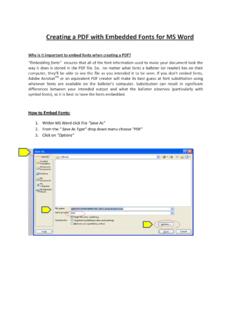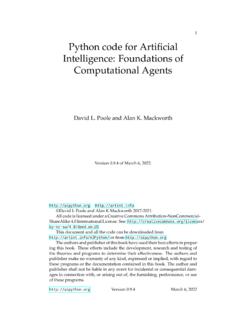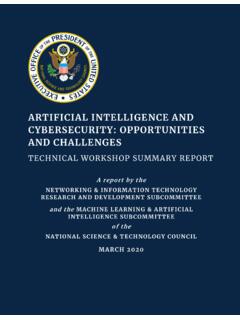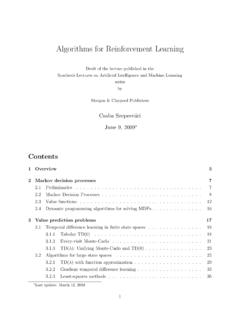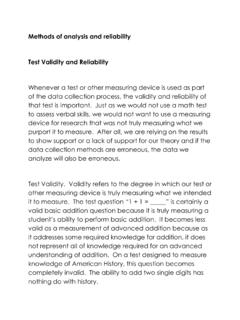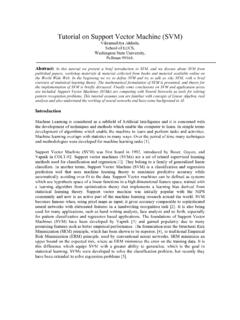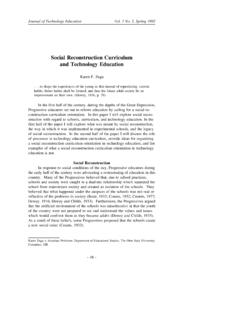Transcription of ETHICALLY ALIGNED DESIGN - Institute of Electrical and ...
1 ETHICALLY . ALIGNED DESIGN . First Edition A Vision for Prioritizing Human Well-being with Autonomous and Intelligent Systems The IEEE Global Initiative on Ethics of Autonomous and Intelligent Systems Table of Contents The views and opinions expressed in this collaborative work are those of the authors and do not necessarily reflect the official policy or position of their respective institutions or of the Institute of Electrical and Electronics Engineers (IEEE). This work is published under the auspices of the IEEE Global Initiative on Ethics of Autonomous and Intelligent Systems for the purposes of furthering public understanding of the importance of addressing ethical considerations in the DESIGN of autonomous and intelligent systems. Please see page 290, How the Document Was Prepared, for more details regarding the preparation of this document.
2 This work is licensed under a Creative Commons Attribution-NonCommercial United States License. The IEEE Global Initiative on Ethics of Autonomous and Intelligent Systems Table of Contents Introduction 2. Executive Summary 3-6. Acknowledgements 7-8. ETHICALLY ALIGNED DESIGN From Principles to Practice 9-16. General Principles 17-35. Classical Ethics in A/IS 36-67. Well-being 68-89. Affective Computing 90-109. Personal Data and Individual Agency 110-123. Methods to Guide Ethical Research and DESIGN 124-139. A/IS for Sustainable Development 140-168. Embedding Values into Autonomous and Intelligent Systems 169-197. Policy 198-210. Law 211-281. About ETHICALLY ALIGNED DESIGN The Mission and Results of The IEEE Global Initiative 282. From Principles to Practice Results of Our Work to Date 283-284. IEEE P7000 Approved Standardization Projects 285-286.
3 Who We Are 287. Our Process 288-289. How the Document was Prepared 290. How to Cite ETHICALLY ALIGNED DESIGN 290. Key References 291. This work is licensed under a Creative Commons Attribution-NonCommercial United States License. The IEEE Global Initiative on Ethics of Autonomous and Intelligent Systems Introduction As the use and impact of autonomous and intelligent systems (A/IS) become pervasive, we need to establish societal and policy guidelines in order for such systems to remain human-centric, serving humanity's values and ethical principles. These systems must be developed and should operate in a way that is beneficial to people and the environment, beyond simply reaching functional goals and addressing technical problems. This approach will foster the heightened level of trust between people and technology that is needed for its fruitful use in our daily lives.
4 To be able to contribute in a positive, non-dogmatic way, we, the techno-scientific communities, need to enhance our self-reflection. We need to have an open and honest debate around our explicit or implicit values, including our imaginary1 around so-called artificial intelligence and the institutions, symbols, and representations it generates. Ultimately, our goal should be eudaimonia, a practice elucidated by Aristotle that defines human well-being, both at the individual and collective level, as the highest virtue for a society. Translated roughly as flourishing , the benefits of eudaimonia begin with conscious contemplation, where ethical considerations help us define how we wish to live. Whether our ethical practices are Western ( , Aristotelian, Kantian), Eastern ( , Shinto, /School of Mo, Confucian), African ( , Ubuntu), or from another tradition, honoring holistic definitions of societal prosperity is essential versus pursuing one-dimensional goals of increased productivity or gross domestic product (GDP).
5 Autonomous and intelligent systems should prioritize and have as their goal the explicit honoring of our inalienable fundamental rights and dignity as well as the increase of human flourishing and environmental sustainability. The goal of The IEEE Global Initiative on Ethics of Autonomous and Intelligent Systems ( The IEEE. Global Initiative ) is that ETHICALLY ALIGNED DESIGN will provide pragmatic and directional insights and recommendations, serving as a key reference for the work of technologists, educators and policymakers in the coming years. ETHICALLY ALIGNED DESIGN sets forth scientific analysis and resources, high-level principles, and actionable recommendations. It offers specific guidance for standards, certification, regulation or legislation for DESIGN , manufacture, and use of A/IS that provably aligns with and improves holistic societal well-being.
6 1. The symbols, values, institutions, and norms of a societal group through which people imagine their lives and constitute their societies. This work is licensed under a Creative Commons Attribution-NonCommercial United States License. 2. The IEEE Global Initiative on Ethics of Autonomous and Intelligent Systems Introduction Executive Summary I. Purpose of ETHICALLY ALIGNED DESIGN , First Edition (EAD1e). Autonomous and intelligent technical systems are specifically designed to reduce the necessity for human intervention in our day-to-day lives. In so doing, these new systems are also raising concerns about their impact on individuals and societies. Current discussions include advocacy for a positive impact, such as optimization of processes and resource usage, more informed planning and decisions, and recognition of useful patterns in big data.
7 Discussions also include warnings about potential harm to privacy, discrimination, loss of skills, adverse economic impacts, risks to security of critical infrastructure, and possible negative long-term effects on societal well-being. Because of their nature, the full benefit of these technologies will be attained only if they are ALIGNED with society's defined values and ethical principles. Through this work we intend, therefore, to establish frameworks to guide and inform dialogue and debate around the non-technical implications of these technologies, in particular related to ethical aspects. We understand ethical to go beyond moral constructs and include social fairness, environmental sustainability, and our desire for self-determination. Our analyses and recommendations in ETHICALLY ALIGNED DESIGN address values and intentions as well as implementations, both legal and technical.
8 They are both aspirational, what we hope or wish should happen, and practical, what we the techno-scientific community and every group involved with and/or affected by these technologies could do for society to advance in positive directions. The analyses and recommendations in EAD1e are offered as guidance for consideration by governments, businesses, and the public at large in the advancement of technology for the benefit of humanity. Chapters in ETHICALLY ALIGNED DESIGN , First Edition 1. From Principles to Practice 7. Methods to Guide Ethical Research and DESIGN 2. General Principles 8. A/IS for Sustainable Development 3. Classical Ethics in A/IS 9. Embedding Values into Autonomous 4. Well-being and Intelligent Systems 5. Affective Computing 10. Policy 6. Personal Data and Individual Agency 11. Law This work is licensed under a Creative Commons Attribution-NonCommercial United States License.
9 3. The IEEE Global Initiative on Ethics of Autonomous and Intelligent Systems Introduction II. General Principles III. Ethical Foundations The ethical and values-based DESIGN , Classical Ethics development, and implementation of By drawing from over two thousand five autonomous and intelligent systems should be hundred years of classical ethics traditions, the guided by the following General Principles: authors of ETHICALLY ALIGNED DESIGN explored 1. Human Rights established ethics systems, addressing both A/IS shall be created and operated to respect, scientific and religious approaches, including promote, and protect internationally secular philosophical traditions, to address human recognized human rights. morality in the digital age. Through reviewing the philosophical foundations that define autonomy 2. Well-being and ontology, this work addresses the alleged A/IS creators shall adopt increased human potential for autonomous capacity of intelligent well-being as a primary success criterion technical systems, morality in amoral systems, for development.
10 And asks whether decisions made by amoral 3. Data Agency systems can have moral consequences. A/IS creators shall empower individuals with the ability to access and securely share their data, to maintain people's capacity to have control over their identity. IV. Areas of Impact 4. Effectiveness A/IS for Sustainable Development A/IS creators and operators shall provide Through affordable and universal access to evidence of the effectiveness and fitness communications networks and the Internet, for purpose of A/IS. autonomous and intelligent systems can be 5. Transparency made available to and benefit populations The basis of a particular A/IS decision should anywhere. They can significantly alter institutions always be discoverable. and institutional relationships toward more 6. Accountability human-centric structures, and they can address A/IS shall be created and operated to provide humanitarian and sustainable development an unambiguous rationale for all decisions made.







